Passport characteristics, scope of delivery and price
| Model name | Gamer Storm Assassin III |
|---|---|
| Model code | DP-GS-MCH7-ASN-3 |
| Type of cooling system | for an air tower processor with active airflow from two heatsinks located on heat pipes |
| Compatibility | motherboards with processor sockets: Intel: LGA 2066/2011-v3/2011/1151/1150/1155/1366; AMD: AM4/AM3+/AM3/AM2+/AM2/FM2+/FM2/FM1 |
| Cooling capacity | Max. TDP 280W |
| Fan type | axial (axial) |
| Fan model | Gamer Storm TF 140S (DFr1402512CM) |
| Fan power | 12 V, 0.21 A |
| Fan dimensions | 140×140×25 mm |
| Fan speed | 400-1400 rpm, with LSP – 450-1000 rpm |
| Fan performance | 153.5 m³/h (90.37 ft³/min), with LSP – 109.3 m³/h (64.33 ft³/min) |
| Fan static pressure | 17.6 Pa (1.79 mmH2O), with LSP 7.9 Pa (0.81 mmH2O) |
| Fan noise level | ≤34.2 dBA, with LSP — ≤26.8 dBA |
| Fan bearing | slip (Fluid Dynamic Bearing) |
| Cooler Dimensions (H×W×D) | 161×140×165 mm |
| Radiator dimensions | 135×138×165 mm |
| Cooler weight | 1464 |
| Radiator material | aluminum plates, copper heat pipes (7 pcs. ∅6 mm) and a copper heat sink |
| Heat sink thermal interface | thermal grease in a syringe |
| Connection | fans: 4-pin headers (power, rotation sensor, PWM control) to the headers of the splitter, and the splitter to the header for the CPU cooler on the motherboard; |
| Peculiarities |
|
| Contents of delivery |
|
| Link to the manufacturer’s website | Gamer Storm Assassin III |
Description
The Gamer Storm Assassin III CPU cooler comes in a colorful box made of thin corrugated cardboard.

On the outer planes of the box, not only the product itself is depicted, but also its description is given, the features and technical characteristics are listed, the equipment is indicated, there are also drawings-drawings with the main dimensions. The inscriptions are mostly in English, but the list of features is duplicated in several languages, including Russian. The radiator is protected by polyethylene foam inserts, the fans are in cardboard boxes, fasteners and accessories are packaged in plastic bags and placed in a cardboard box with several compartments.
Comes with a small brochure for installation instructions. Instructions in pictures with a minimum number of inscriptions in English, so it does not need translation. Its quality is good. On the company’s website, we found a link to the same manual in the form of a PDF file.
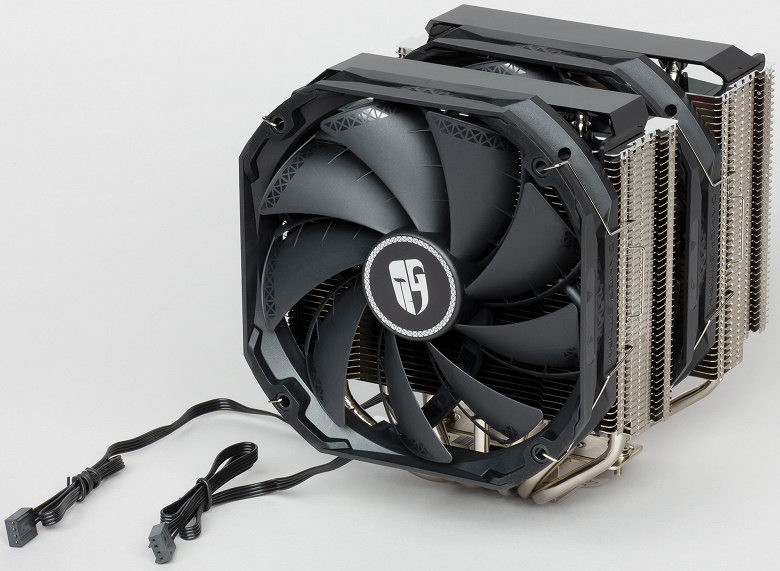
The cooler is equipped with a remote double radiator, to which heat is transferred from the sole through seven heat pipes with a diameter of 6 mm. Copper tubes, nickel-plated on the outside. The heat sink consists of a metal block (probably aluminum with a nickel-plated surface) on top and a copper plate on the bottom. Heat pipes run in grooves between these two parts. Solder is used to connect the tubes and parts of the heat sink.

The sole of the heat sink is polished, but not polished, it has small concentric grooves. In the direction perpendicular to the heat pipes, the sole is convex with a difference of about 0.3 mm, along the pipes the surface is less convex. Before installation, the sole is protected by a plastic film.
There is no pre-applied thermal interface, but the manufacturer attached a syringe with thermal paste to the cooler. The syringe looks relatively large, but it is opaque, so it is not clear how much thermal paste is actually there. The tests used thermal paste from another manufacturer. Looking ahead, we will demonstrate the distribution of thermal paste after the tests are completed. On an Intel Core i9-7980XE processor:

And on the sole of the heat sink:

It can be seen that the thermal paste was distributed in a thin layer over almost the entire plane of the processor cover, and its excess was squeezed out along the edges. In the center there is a pronounced spot of tight contact.
And in the case of the AMD Ryzen 9 3950X processor. On processor:
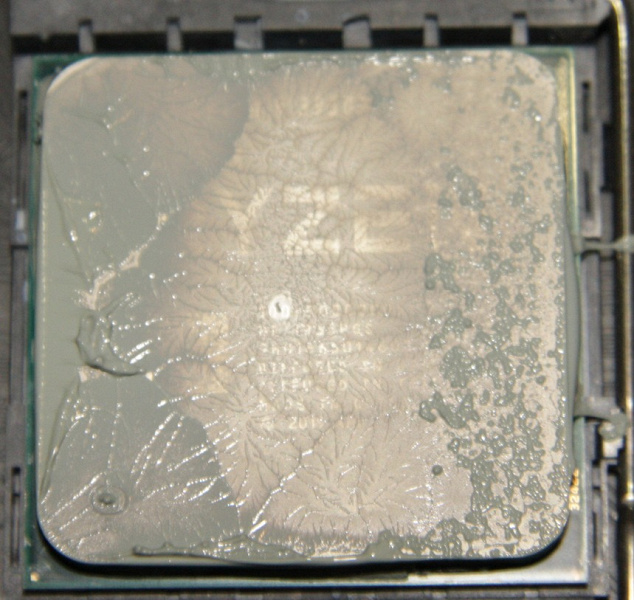
On the sole of the heat sink:

In this case, there is also a central spot of tight contact, and it is clearly seen that the thermal paste layer is thinner along the heat pipes.
The radiator consists of two stacks of aluminum plates with a nickel-plated surface, tightly mounted on heat pipes and soldered to them. With the exception of the upper plates made of aluminum without coating and with a mirror-smooth surface, which perform mainly a decorative function.
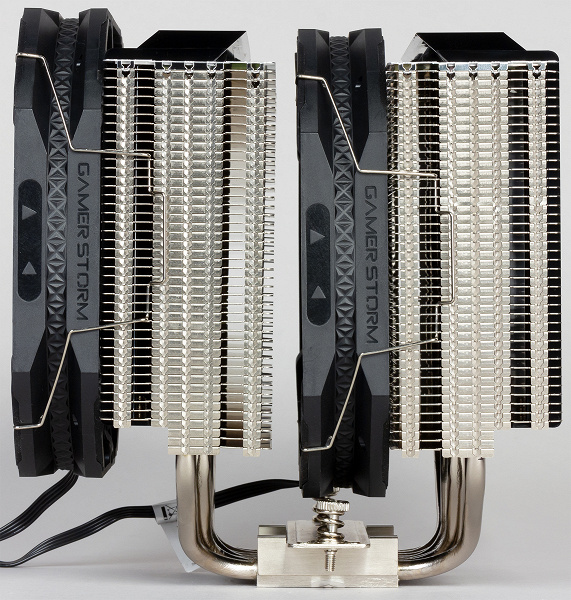
The width of the fan is slightly larger than the working plane of the radiator, and the height is much larger, so part of the air flow inevitably passes by the plates. The blowing efficiency of the plates is slightly increased by the use of black plastic guide covers.

The standard size of the complete fans is 140×140 mm. Frame height 25 mm. The fan is pressed against the radiator with two steel brackets. It is convenient that the brackets are fixed in the holes of the frame and do not fall out. There are rubber pads on the fan frame near the mounting holes. In theory, these elastic elements should reduce vibration noise, but in practice this will not happen, since the mass of the fan and the rigidity of the vibration damping elements make it possible to reasonably assume that, due to the high resonant frequency, this system will in any case not have any significant anti-vibration properties. In addition, the brackets cling directly to the fan frame itself and to the radiator fins, these rigid connections generally exclude any vibration isolation even in theory.

The cooler fans have a four-pin connector (common, power, rotation sensor and PWM control) at the end of the flat cable. Both fans are connected to a splitter, which in turn is connected to the fan header on the system board. In this option, the rotation speed of only one fan will be monitored. However, there is usually no shortage of fan headers on modern motherboards, so each of the fans can be connected to its own connector and a splitter is not used. The cooler comes with a pair of LSP inserts with two connectors that reduce the maximum fan speed. In these inserts, a resistor is soldered into the power wire break, on which part of the power supplied to the fan is dissipated.
The metal parts of the fasteners on the processor are made of hardened steel and have a durable galvanized coating. The mounting plate on the back of the motherboard is made of hard plastic and equipped with stiffeners. Attaching to the processor is a bit difficult because the fan has to be installed between the heatsinks after the heatsink is fixed to the processor, but this is relatively easy to do. The package includes a screwdriver and a few other useful and not so trifles.

According to the manufacturer, the cooler allows you to install RAM modules up to 54 mm high. This is the distance from the side to the lower radiator fins. But as you can see in the photo below, the bottom edge of the fan drops below the fins in a typical installation, leaving less room for memory modules. However, the fan can be mounted a little higher if the PC case allows it. Also, the cooler can be turned so that there is no fan above the memory slots. In general, there are options.
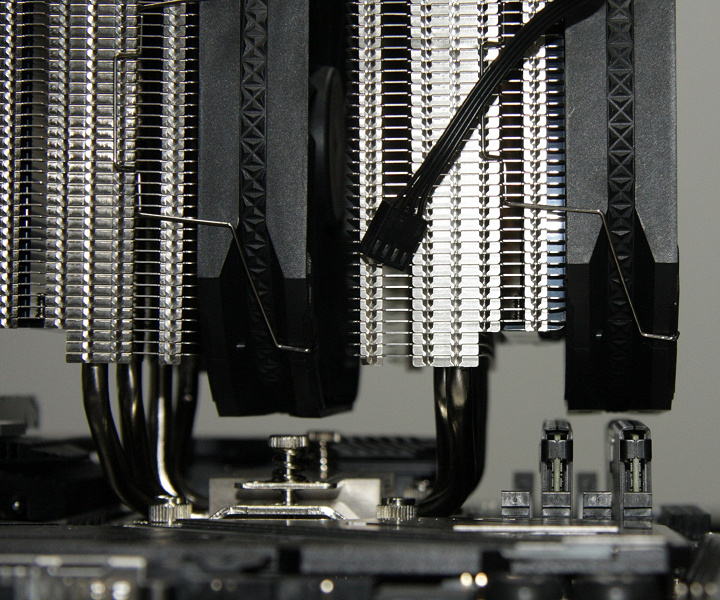
Testing
Below in the summary table we present the results of measurements of a number of parameters.
| Cooler dimensions (fans in the central position, H×W×D), mm | 180×140×159 |
|---|---|
| Fin dimensions (one stack of plates, H×W×D), mm | 112×138×50 |
| Cooler weight, g | 1287 (with mounting kit for LGA 2011) |
| Mass of the radiator only, g | 916 |
| Radiator fin thickness (approx.), mm | 0.4 |
| Heat sink dimensions (W×D), mm | 45×43 |
| Fan power cable length, mm | 400 |
| Fan power splitter length, mm | 505+102 |
| LSP insert length, mm | 80 |
| Resistor resistance in the LSP insert, Ohm | 33 |
A full description of the testing methodology is given in the corresponding article ” Testing methodology for processor coolers of the 2020 sample “. For the load test, the Stress FPU function from the AIDA64 package was used. In this test, all cores of the Intel Core i9-7980XE processor were running at 2.6 GHz. Correspondingly, the processor consumption when measured by the additional 12 V connector on the motherboard under load varied from 197 W at 54 °C of the processor temperature to 203 W at 80 °C. Having performed all the tests in such conditions, we decided that this is too low a load for such a cooler. On the second run, the powerMax (AVX) program was used for the load test, all cores of the Intel Core i9-7980XE processor worked at a fixed frequency of 3.2 GHz (multiplier 32). In this case, the CPU consumption, as measured by the 12V auxiliary socket, varied from 270W at 63°C to 285W at 88°C.
Determination of the dependence of the cooler fan speed on the PWM duty cycle and / or supply voltage

The rotation speed adjustment range is quite wide, although already at a duty cycle (SC) below 35%, the rotation speed stops changing. When it drops to short circuit 0, the fan does not stop. This may be of value if the user wants to create a hybrid cooling system that operates fully or partially in passive mode at low load. Using the LSP insert allows you to reduce the rotation speed in the short circuit range from 35% to 100%.

Adjustment using voltage allows you to get a stable rotation in about the same range as in the case of using PWM. The fan stops when the voltage drops to 2.8 V and starts from 2.9 V. If necessary, the fan can be connected to a 5 V source. Using the LSP insert allows you to reduce the rotation speed over the entire range, but it stops working below 4.0 V rotation sensor, and indeed below 5 V there is no confidence in its testimony. If the LSP is connected, the fan stops when the voltage drops to 3.1-3.2 V and starts from 4.1 V.
Determining the dependence of the temperature of the processor when it is fully loaded on the speed of the cooler fan
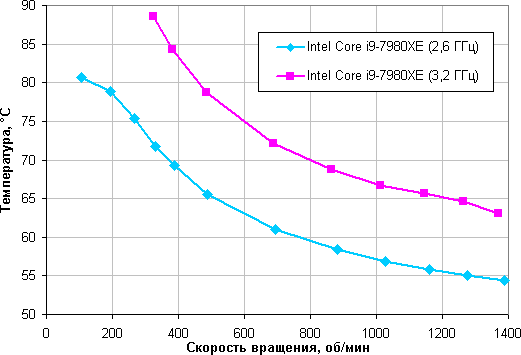
Under test conditions (ambient temperature 24 degrees), the Intel Core i9-7980XE processor with a TDP of 165 W does not overheat even at the minimum fan speed when adjusted using only PWM. You can even leave a short circuit of 30% and lower the fan supply voltage to 10 V in the case of a powerMax load and operating at a frequency of 3.2 GHz, and even to 4 V (Stress FPU and 2.6 GHz), while the temperature still remains below the critical .
Determining the noise level depending on the speed of the cooler fan

In this test, we changed not only the short circuit, but also the voltage, reducing it to 4, 6, 8 and 10 V at the first four points, respectively, at short circuit = 30%. It depends, of course, on individual characteristics and other factors, but in the case of coolers somewhere from 40 dBA and above, the noise, from our point of view, is very high for a desktop system, from 35 to 40 dBA, the noise level is tolerable, below 35 dBA noise from the cooling system will not stand out much against the background of typical non-noise PC components – fans in the case, in the power supply and on the video card and hard drives, and somewhere below 25 dBA the cooler can be called conditionally silent. This cooler can work both quite noisily and almost silently.
Plotting the dependence of the noise level on the temperature of the processor at full load

Plotting the dependence of the real maximum power on the noise level
Let’s try to get away from the conditions of the test bench to more realistic scenarios. Let’s say that the air temperature inside the case can rise to 44 ° C, but the temperature of the processor under maximum load does not want to increase above 80 ° C. Restricting ourselves to these conditions, we construct the dependence of the real maximum power consumed by the processor on the noise level:

Taking 25 dBA as a conditional noiselessness criterion, we get the maximum power of processors corresponding to this level. That’s roughly 200W and 215W for the Stress FPU/2.6GHz and powerMax/3.2GHz combinations, respectively. Hypothetically, if you do not pay attention to the noise level, the power limits can be increased somewhere else up to 230-250 watts. Once again, we will clarify: this is in harsh conditions of blowing the radiator with air heated to 44 degrees; as the air temperature drops, the specified power limits for silent operation and maximum power increase. The small discrepancy for different loads and operating frequencies can be explained by several reasons. The Stress FPU test, compared to other stress tests at the same power consumption, usually warms up the processor more (or rather, temperature sensors, it is also possible that the processor microcode for such a load increases the value from the sensor in order to protect the loaded unit from overheating). In addition, under a higher load (powerMax/3.2 GHz), the cooler’s heatsink heats up more, which slightly increases the contribution of convection and radiation to heat transfer. Also, under greater load, the efficiency of the voltage regulator may decrease, and more power is dissipated on its heatsink (recall that we are measuring the power transmitted to the 12 V power connector of the processor). However, in any case, a discrepancy of approximately 10% cannot be considered significant.
Using this link , you can calculate the power limits for other boundary conditions (air temperature and maximum processor temperature) and compare this system with several other coolers tested using the same method (the list is updated, for this cooler the results for the powerMax / 3.2 GHz variant are shown ).
Testing on an AMD Ryzen 9 3950X processor
As an additional test, we decided to see how the cooler handles the cooling of the AMD Ryzen 9 3950X . The processors of the Ryzen 9 family are assemblies of three crystals under one cover. On the one hand, increasing the area from which heat is removed can improve the cooling capacity of the cooler, but on the other hand, the design of most coolers is optimized for better cooling of the central area of the processor. Apparently, because of these features, there is an opinion that it is not very easy to choose an air cooler for the top new generation Ryzen processors. The tests used the specified processor and ASRock X570 Taichi motherboard . All processor cores worked at a fixed frequency of 3.6 GHz (multiplier 36). To set this frequency, the A-Tuning program from the motherboard manufacturer was used. The powerMax program was used as a load test (using the AVX command system). Processor consumption measured from the two additional 12V sockets on the motherboard under load varied from 152W at 63°C CPU temperature to 163W at 86°C.
The dependence of the temperature of the processor at its full load on the speed of rotation of the fans:

In fact, this processor does not overheat at 24 degrees of ambient air even at the minimum fan speed if it is adjusted using only PWM. You can even leave a short circuit of 30% and lower the supply voltage of the fans to 6 V, while the temperature still remains below the critical one.
The dependence of the noise level on the temperature of the processor at full load:
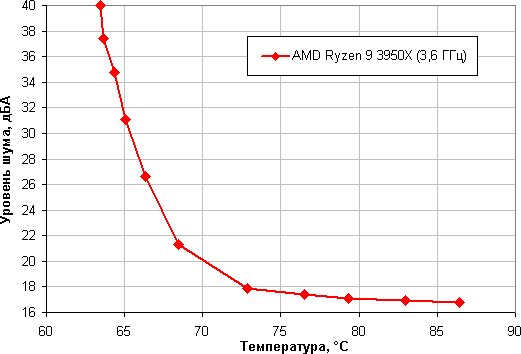
Restricting ourselves to the above conditions, we plot the dependence of the real maximum power (denoted as Max. TDP) consumed by the processor on the noise level:
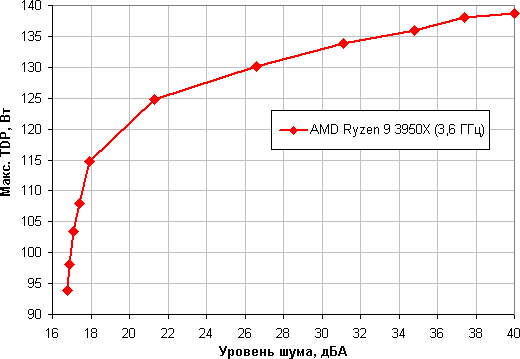
Taking 25 dBA as a conditional noiselessness criterion, we get that the maximum processor power corresponding to this level is about 128 watts. If you do not pay attention to the noise level, then the power limit can be increased somewhere up to 138 watts. Once again, we will clarify: this is in harsh conditions of blowing the radiator with air heated to 44 degrees. As the air temperature drops, the specified power limits for quiet operation and maximum power increase. The result is noticeably worse than in the case of the Intel Core i9-7980XE processor. This can be explained by the fact that the heat sink of the cooler has a tight contact area in the center, and towards the edges the thickness of the thermal paste layer increases and the heat transfer efficiency decreases. However, provided there is enough good ventilation in the case, this cooler will quite cope with the cooling of the AMD Ryzen 9 3950X processor, but you should not count on the possibility of significant overclocking.
You can use this link to calculate power limits for other boundary conditions (air temperature and maximum processor temperature).
findings
Using the Gamer Storm Assassin III cooler, you can create a conditionally silent computer (noise level of 25 dBA or less) equipped with an Intel Core i9-7980XE (Intel LGA2066, Skylake-X (HCC)) processor, if the processor consumption under maximum load does not exceed 200W and the temperature inside the case will not rise above 44°C. In the case of the AMD Ryzen 9 3950X chiplet processor, the cooler efficiency is noticeably lower, and to meet the above conditions, the maximum power consumed by the processor must be below 130 watts. With lower cooling air temperatures and/or less stringent noise requirements, the power limits can be significantly increased. The cooler is notable for its neat appearance without unnecessary embellishments and illumination, quite convenient installation, the ability to use it together with memory modules with high heatsinks, and also an excellent package bundle. The latter we will celebrate with an editorial award:

In conclusion, we invite you to watch our video review of the Gamer Storm Assassin III cooler:
Our video review of the Gamer Storm Assassin III cooler can also be viewed at iXBT.video




